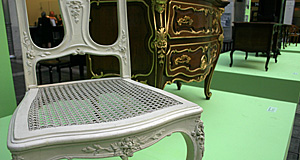Möbelmusem or Kaiserliches Hofmobiliendepot:
Imperial Museum of Furniture, Vienna

One of the topic-wise weirdest museums of Vienna, yet a jolly interesting one is the Möbelmuseum or Kaiserliches Hofmobiliendepot or "Court Furniture Stock". Since the Habsburgs owned all sorts of huge, huge palaces, they didn′t want to afford furniture and interiors for all of them - and they didn′t need to, either, as they always lived in one or two palaces at one time only.

So they just had to schedule arrival and departure and the Hofmobilieninspektor or "Court Interiors Executive Assistant" (surely a flamboyantly gay Frenchmen, but that might be just my imagination) arranged a nice setting to make the Kaisers feel all fine and comfortable upon their arrival. In rooms that had been empty only days before. A fantastic system.
Anyway, when the Habsburgs got their butt kicked and ended up in exile in Switzerland, the - now - Republic of Austria suddenly owned a great deal of furniture, carpets, and other decorative items. Since there was much more stuff than needed to fill up all palaces (for example the one of the President in the Neue Burg wing of the Hofburg, where it is still used for representative dinners and alike) anyone could have wanted, they left things where they were and made the stock a museum. A very odd and highly interesting one, though.
Vienna′s biggest Furniture Collection: Möbelmuseum
There you can see personal chairs of various Emperors and one or another throne, a nice array of Biedermeier spittoons, Emperor Maximilian of Mexico′s 19th century super-sized sombrero (a set with his walking stick), and a vast number of "Hygienemöbel" ("hygiene furniture") consisting of bed pans and alike.

The wild array is structured into several galleries that were recently refurbished. In total, there are some 650,000 items on display, many of them were made by famous artists: Adolf Loos, Otto Wagner and Josef Hoffmann have all contributed to the Habsburg′s interiors up to the early 20th century. It goes back pretty far in history, too: The Kaiserliche Hofmobiliendepot was founded by Empress Maria Theresia in 1747 and constantly developed since then. From 1809 onwards, the staff of the Hofmobiliendepot also supervised the purchase of new furniture. The current building was made the depot in 1907.
Today, it is associated with and administered by the Schloss Schönbrunn Palace. If you are looking for a rainy day option that you want to combine with a typically Imperial-Austrian attraction, I would certainly recommend the Hofmobiliendepot.
Other nearby attractions include the Naschmarkt and the Haus des Meeres, although the Hofmobiliendepot itself is located in the 7th district, which is a busy (and expensive) commercial and residential area not very rich in sightseeing attractions. It might provide you with an opportunity to stroll around Vienna and learn what the real people do - at least those working for advertising companies, PR agencies or small media businesses.
back to "vienna
travel guide"
Vienna by District
District Overview - 1st (Innere Stadt) - 2nd (Leopoldstadt) - 3rd (Landstraße) - 4th (Wieden) - 5th (Margareten)- 6th (Mariahilf) - 7th (Neubau) - 8th (Josefstadt) - 9th (Alsergrund) - 10th (Favoriten) - 11th (Simmering) - 12th (Meidling) - 13th (Hietzing) - 14th (Penzing) - 15th (Fünfhaus) - 16th (Ottakring) - 17th (Hernals) - 18th (Währing) - 19th (Döbling) - 20th (Brigittenau) - 21st (Floridsdorf) - 22nd (Donaustadt) - 23rd (Liesing) - Ringstraße - Surroundings
Further Reading
Official Website of the Hofmobiliendepot
